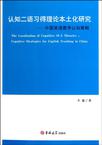认知二语习得理论本土化研究
出版时间:2010-8 出版社:吉林大学出版社 作者:牛强 页数:350
内容概要
《认知二语习得理论本土化研究:中国英语教学认知策略》内容包括认知心理学、心理语言学、二语习得理论、外语教学法和外语测试五个方面的知识。是外语研究者和外语工作者应该了解和具备的元语言、元认知知识的总和。掌握这些知识,将帮助广大外语教学解开一些迷惑,如石化现象发生的认知原因是什么?有意识记忆力和无意识记忆力的工作原理是怎样的?遗忘是怎样产生的?如何有意识缩短孵化期使理解和产生能力同时得到发展?技能习得遵循怎样的规律?外语教学史上都经历过那些教学法演变?学生吸收何种输入、产出何种输出才能将输入最大化、最优化地转化为输出?通过影视习得英语中,应采取哪些影视作品和方法?外语测试的基本概念和特点以及出外语多项选择题的注意事项?如何使学生达到课外学习自主?等一系列外语学习策略的问题。 《认知二语习得理论本土化研究:中国英语教学认知策略》特点: 1.《认知二语习得理论本土化研究:中国英语教学认知策略》将认知心理学、第二语言习得、外语教学法和外语测试的理论综合于一体。 2.《认知二语习得理论本土化研究:中国英语教学认知策略》不但涵盖了二语习得的经典理论,也介绍了最新研究成果。 3.《认知二语习得理论本土化研究:中国英语教学认知策略》不是对西方理论进行简单的梳理,而是将西方先进的认知二语习得成果应用于中国母语环境下的英语教学,提出了一些新的理论和学习策略。 4.《认知二语习得理论本土化研究:中国英语教学认知策略》针对中国英语学习环境而论,因此,一些理论如formal instruction和强调social interaction的理论,不是《认知二语习得理论本土化研究:中国英语教学认知策略》重点。 创新点: 《认知二语习得理论本土化研究:中国英语教学认知策略》为我国认知二语习得理论的本土化应用研究,做了一个初步尝试。 1.我们首次将二语习得理论划分为前认知(Pre-cognitive)和后认知(Post-cognitive)理论阶段,从而使读者对二语研究由90年代前以研究客体——目的语为主,转向90年代后研究主体——学习者认知特点为主的过渡,一目了然。 2.我们提出了一系列的认知策略,并以词汇和语法教学为例,分别说明如何将接受性技能转化为产出型技能。《认知二语习得理论本土化研究:中国英语教学认知策略》提出的认知策略有:故意/有意注意策略、重复式、间隔式输入策略、关键词策略、词块学习策略、概念排除策略、变化语境策略、及时产出策略。这些策略是针对学习者主体而言。要实施这些策略,还要通过客体——输入和输出的特点和分类得以实现,从而实现将输入最大化、最优化地转化为输出的外语学习目的。 3.在输入研究上,基于Krashen理论和信息加工特点,我们拓展增加了最佳语言输入的特点。 4.在输出研究上,基于Swain理论和自动化特点,我们提出了五种输出类别以及各自功能,比便避免由自动化而产生的石化。 5.教学法上,我们提出了实现以上理论模式的,利用影视英语教学的整体教学法(Holistic Approach),并提出了利用电影教学的认知策略。 6.通过最新习得起始年龄研究,我们提出了我国语言规划的政策和出路之一是缩短外语教育时间,并提出了平衡普通话、方言和英语教育关系的长远政治意义。
作者简介
牛强,1968年8月生于辽宁省沈阳市,1996年硕士毕业于吉林大学英语系,1999年6月博士毕业于上海外国语大学,1999年一2005年任教同济大学,2005年至今任教长春大学。2008年8月一2009年8月访学美国卡耐基梅陇大学心理学系记忆力实验室。主要研究方向为心理语言学和第二语言习得研究,已教授研究生课程《心理语言学》和《外语教学与测试》,本科生《教师技能培训》《英语学习技巧》等多门课程。
书籍目录
内容提要AbbreviationsChapter 1 Cognitive theories relevant to second language acquisition1.1 A general review of memory1.1.1 Definition of memory: What is memory?1.1.2 Types of memory1.1.3 The mechanisms of memory : Register, retention and retrieval (3R)1.1.4 Functions of Memory.. What affects what we remember?1.2 Mental lexicon :1.2.1 Dimensions of word knowledge: what is stored in the mental lexicon1.2.2 Organization of the mental lexicon1.2.3 Models of lexical access1.2.4 The representation of a biIingual s mental lexicon1.3 Power-law learning1.4 Characteristics of language skill learningConclusionChapter 2 Second language acquisition: key concepts and theories2.1 Pre-cognitive SLA period: key figures and their contributions2.1.1 Pit Corder and error analysis2.1.2 Larry Selinker and Interlanguage fossilization2.1.3 Stephen Krashen and his famous five hypotheses2.1.4 Swain s Comprehensible Output hypothesis2.1.5 Language transfer and mother tongue interference2.1.6 Individual Differences or learner characteristics2.2 Post-cognitive SLA period: representatives and their areas of research2.2.1 Explicit knowledge versus implicit knowledge2.2.2 Richard Sehmidt s Attention hypothesis2.2.3 Maclaughlin s information processing model2.2.4 Anderson s Adaptive Control of Thought (ACT) model2.2.5 Fodor and Modularity2.2.6 Connectionist model of SLA2.2.7 MacWhinney s Competition Model2.2.8 Pienemann and Processability theory2.2.9 Nick Ellis and the Chunking Strategy in SLA2.2.10 Bialystok s Analysis-Control model and distinction between analyzed and unanalyzed knowledge 1142. 2.11 VanPattem s Input and output hypothesisConclusionChapter 3 From Language Acquisition to Foreign Language Learning3.1 From Language Acquisition to Foreign Language Learning3.2 Left-hemisphere lateralization and Plasticity3.3 Chomsky and his Universal Grammar3.4 Language Learning: Types of comparisons and contrast3.4.1 Child first language acquisition vs adult foreign language learning3.4.2 Child second language acquisition vs adult second language acquisition3.4.3 Second language acquisition vs foreign language learning3.5 A pedagogical implication: Age of Acquisition3.5.1 language and Cognition: the effects of multilingualism3.5.2 The Mediated Role of Language in the Development of Human Higher Mental Functions3.5.3 Different approaches to learners of different ages3.5.4 Implication: language planning in ChinaConclusionChapter 4 Implications of cognitive theories for SLA: metacognitive strategies for FLL4.1 Change of orientation on learner strategy research4.2 Need of strategy instruction and learner autonomy4.3 Ways to raise learners consciousness of learner strategies4.4 Metaognifive strategies in teaching grammar4.4.1 GrAmmatical knowledge versus grammatical competence4.4.2 Linguistic grammar versus pedagogic grammar4.4.3 Grammar core and grammar peripherals4.4.4 Comprehension ability and production ability4.4.5 A tentative approach to grammar teaching4.5 Metacognitive strategies in teaching vocabulary4.5.1 Types of vocabulary4.5.2 Metacoguitive strategies in converting receptive vocabulary into productive vocabularyConclusionChapter 5 The Optimal Input and Optimal Output hypothesis5.1 Psychological basis5.1.1 Relation between language and thought5.2 The optimal input hypothesis5.2.1 The role of input5.2.2 Characteristics of optimal input5.3 The Optimal Output hypothesis5.3.1 The role of output5.3.2 Types of output5.3.3 A Pedagogical Implication : Learning from outputConclusionChapter 6 Foreign Language Teaching methodologies6.1 The Grammar-Translation method6.2 The Direct method6.3 The Oral approach or the Situational language teaching6.4 The Audiolingual Method6.5 Communicative Language Teaching6.6 Total Physical Response (TPR)6.7 The Silent Way ..6.8 Community Language Learning6.9 The Natural Approach6.10 Suggestopedia6.11 Teaching English through movies —— a Holistie ApproachConclusionChapter 7 Foreign Language Testing7.1 Types of tests and their functions7.2 Backwash Effect7.3 Criteria of tests7.4 Interpreting test scores7.4.1 Measures of Central Tendency7.4.2 Measures of Dispersion7.5 Item Analysis7.6 A Sample of erroneous Multiple Choice Questions7.7 A summary of the principles we should observe in designing good MCQ itemsBibliography
图书封面
评论、评分、阅读与下载
